FORD E SERIES 2000 4.G Natural Gas Vehicle Supplement Manual
Manufacturer: FORD, Model Year: 2000, Model line: E SERIES, Model: FORD E SERIES 2000 4.GPages: 16, PDF Size: 0.12 MB
Page 11 of 16
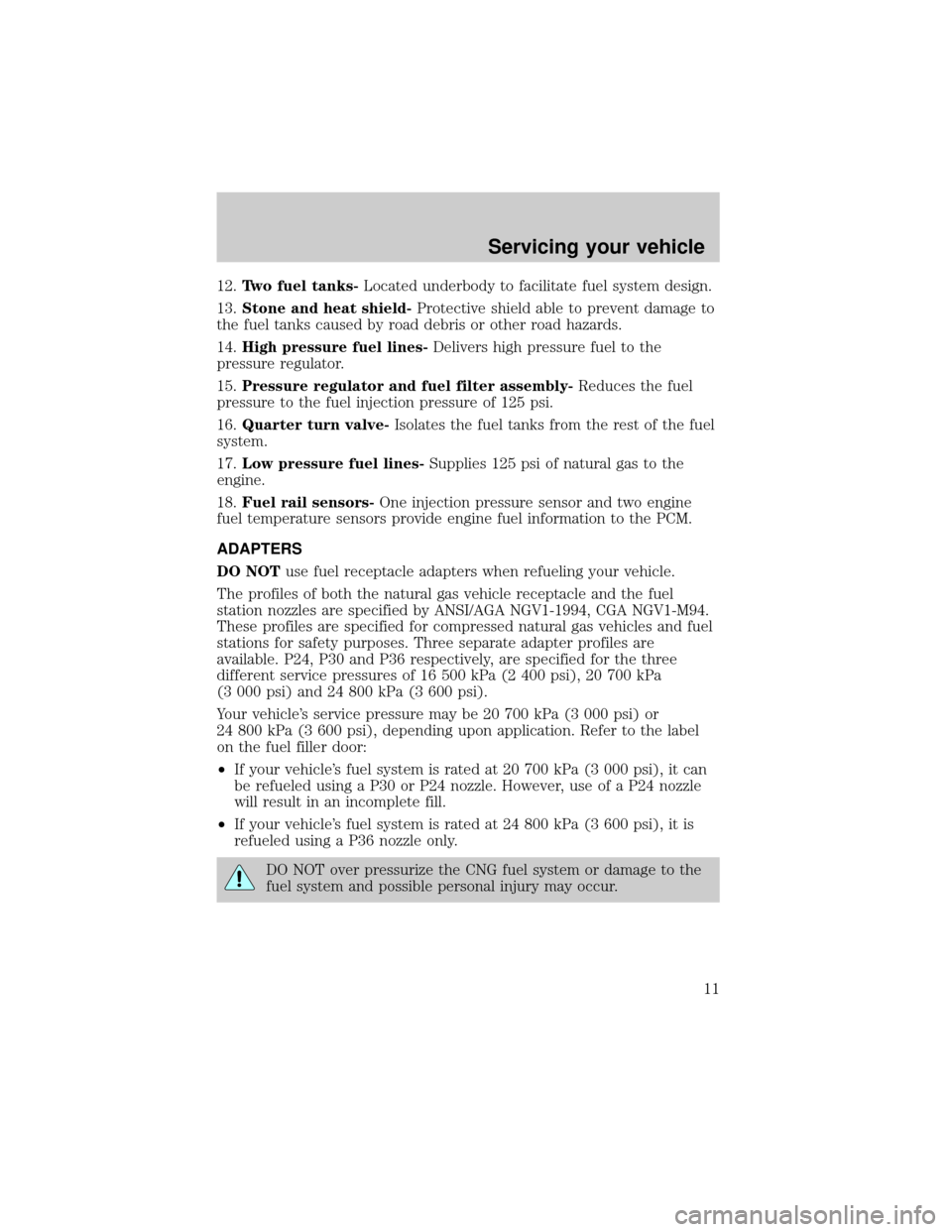
12.Two fuel tanks-Located underbody to facilitate fuel system design.
13.Stone and heat shield-Protective shield able to prevent damage to
the fuel tanks caused by road debris or other road hazards.
14.High pressure fuel lines-Delivers high pressure fuel to the
pressure regulator.
15.Pressure regulator and fuel filter assembly-Reduces the fuel
pressure to the fuel injection pressure of 125 psi.
16.Quarter turn valve-Isolates the fuel tanks from the rest of the fuel
system.
17.Low pressure fuel lines-Supplies 125 psi of natural gas to the
engine.
18.Fuel rail sensors-One injection pressure sensor and two engine
fuel temperature sensors provide engine fuel information to the PCM.
ADAPTERS
DO NOTuse fuel receptacle adapters when refueling your vehicle.
The profiles of both the natural gas vehicle receptacle and the fuel
station nozzles are specified by ANSI/AGA NGV1-1994, CGA NGV1-M94.
These profiles are specified for compressed natural gas vehicles and fuel
stations for safety purposes. Three separate adapter profiles are
available. P24, P30 and P36 respectively, are specified for the three
different service pressures of 16 500 kPa (2 400 psi), 20 700 kPa
(3 000 psi) and 24 800 kPa (3 600 psi).
Your vehicle's service pressure may be 20 700 kPa (3 000 psi) or
24 800 kPa (3 600 psi), depending upon application. Refer to the label
on the fuel filler door:
²If your vehicle's fuel system is rated at 20 700 kPa (3 000 psi), it can
be refueled using a P30 or P24 nozzle. However, use of a P24 nozzle
will result in an incomplete fill.
²If your vehicle's fuel system is rated at 24 800 kPa (3 600 psi), it is
refueled using a P36 nozzle only.
DO NOT over pressurize the CNG fuel system or damage to the
fuel system and possible personal injury may occur.
Servicing your vehicle
11
Page 12 of 16
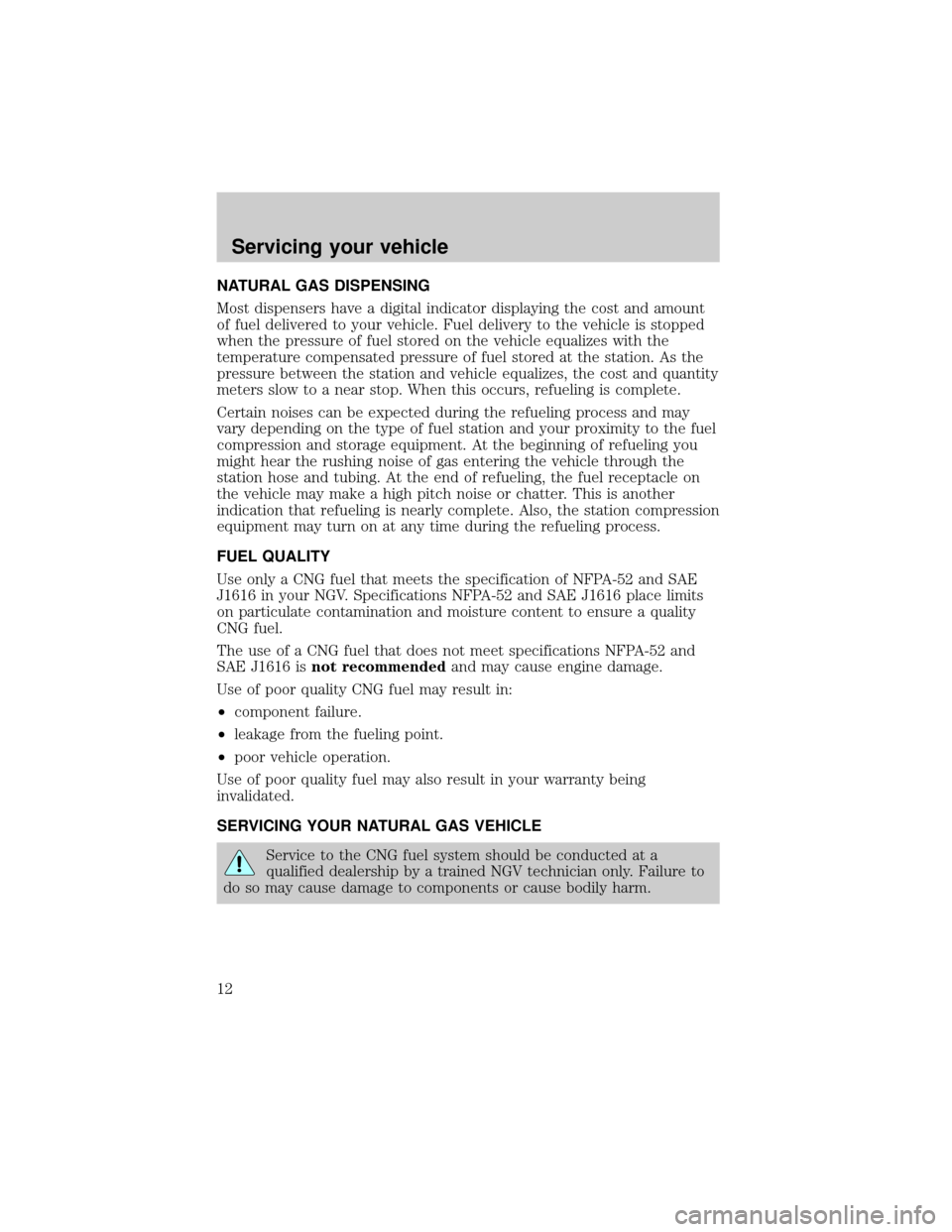
NATURAL GAS DISPENSING
Most dispensers have a digital indicator displaying the cost and amount
of fuel delivered to your vehicle. Fuel delivery to the vehicle is stopped
when the pressure of fuel stored on the vehicle equalizes with the
temperature compensated pressure of fuel stored at the station. As the
pressure between the station and vehicle equalizes, the cost and quantity
meters slow to a near stop. When this occurs, refueling is complete.
Certain noises can be expected during the refueling process and may
vary depending on the type of fuel station and your proximity to the fuel
compression and storage equipment. At the beginning of refueling you
might hear the rushing noise of gas entering the vehicle through the
station hose and tubing. At the end of refueling, the fuel receptacle on
the vehicle may make a high pitch noise or chatter. This is another
indication that refueling is nearly complete. Also, the station compression
equipment may turn on at any time during the refueling process.
FUEL QUALITY
Use only a CNG fuel that meets the specification of NFPA-52 and SAE
J1616 in your NGV. Specifications NFPA-52 and SAE J1616 place limits
on particulate contamination and moisture content to ensure a quality
CNG fuel.
The use of a CNG fuel that does not meet specifications NFPA-52 and
SAE J1616 isnot recommendedand may cause engine damage.
Use of poor quality CNG fuel may result in:
²component failure.
²leakage from the fueling point.
²poor vehicle operation.
Use of poor quality fuel may also result in your warranty being
invalidated.
SERVICING YOUR NATURAL GAS VEHICLE
Service to the CNG fuel system should be conducted at a
qualified dealership by a trained NGV technician only. Failure to
do so may cause damage to components or cause bodily harm.
Servicing your vehicle
12
Page 13 of 16
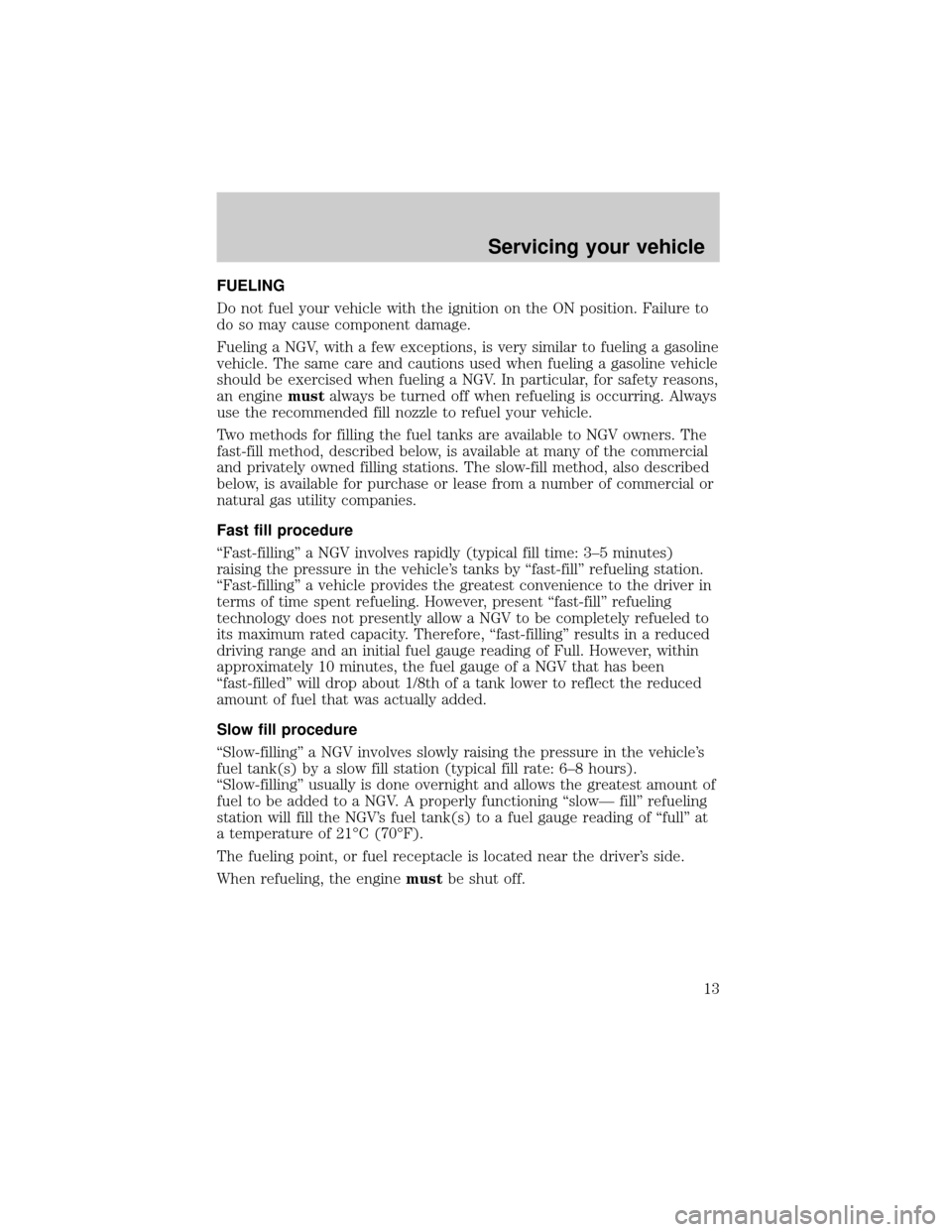
FUELING
Do not fuel your vehicle with the ignition on the ON position. Failure to
do so may cause component damage.
Fueling a NGV, with a few exceptions, is very similar to fueling a gasoline
vehicle. The same care and cautions used when fueling a gasoline vehicle
should be exercised when fueling a NGV. In particular, for safety reasons,
an enginemustalways be turned off when refueling is occurring. Always
use the recommended fill nozzle to refuel your vehicle.
Two methods for filling the fuel tanks are available to NGV owners. The
fast-fill method, described below, is available at many of the commercial
and privately owned filling stations. The slow-fill method, also described
below, is available for purchase or lease from a number of commercial or
natural gas utility companies.
Fast fill procedure
ªFast-fillingº a NGV involves rapidly (typical fill time: 3±5 minutes)
raising the pressure in the vehicle's tanks by ªfast-fillº refueling station.
ªFast-fillingº a vehicle provides the greatest convenience to the driver in
terms of time spent refueling. However, present ªfast-fillº refueling
technology does not presently allow a NGV to be completely refueled to
its maximum rated capacity. Therefore, ªfast-fillingº results in a reduced
driving range and an initial fuel gauge reading of Full. However, within
approximately 10 minutes, the fuel gauge of a NGV that has been
ªfast-filledº will drop about 1/8th of a tank lower to reflect the reduced
amount of fuel that was actually added.
Slow fill procedure
ªSlow-fillingº a NGV involves slowly raising the pressure in the vehicle's
fuel tank(s) by a slow fill station (typical fill rate: 6±8 hours).
ªSlow-fillingº usually is done overnight and allows the greatest amount of
fuel to be added to a NGV. A properly functioning ªslowÐ fillº refueling
station will fill the NGV's fuel tank(s) to a fuel gauge reading of ªfullº at
a temperature of 21ÉC (70ÉF).
The fueling point, or fuel receptacle is located near the driver's side.
When refueling, the enginemustbe shut off.
Servicing your vehicle
13
Page 14 of 16
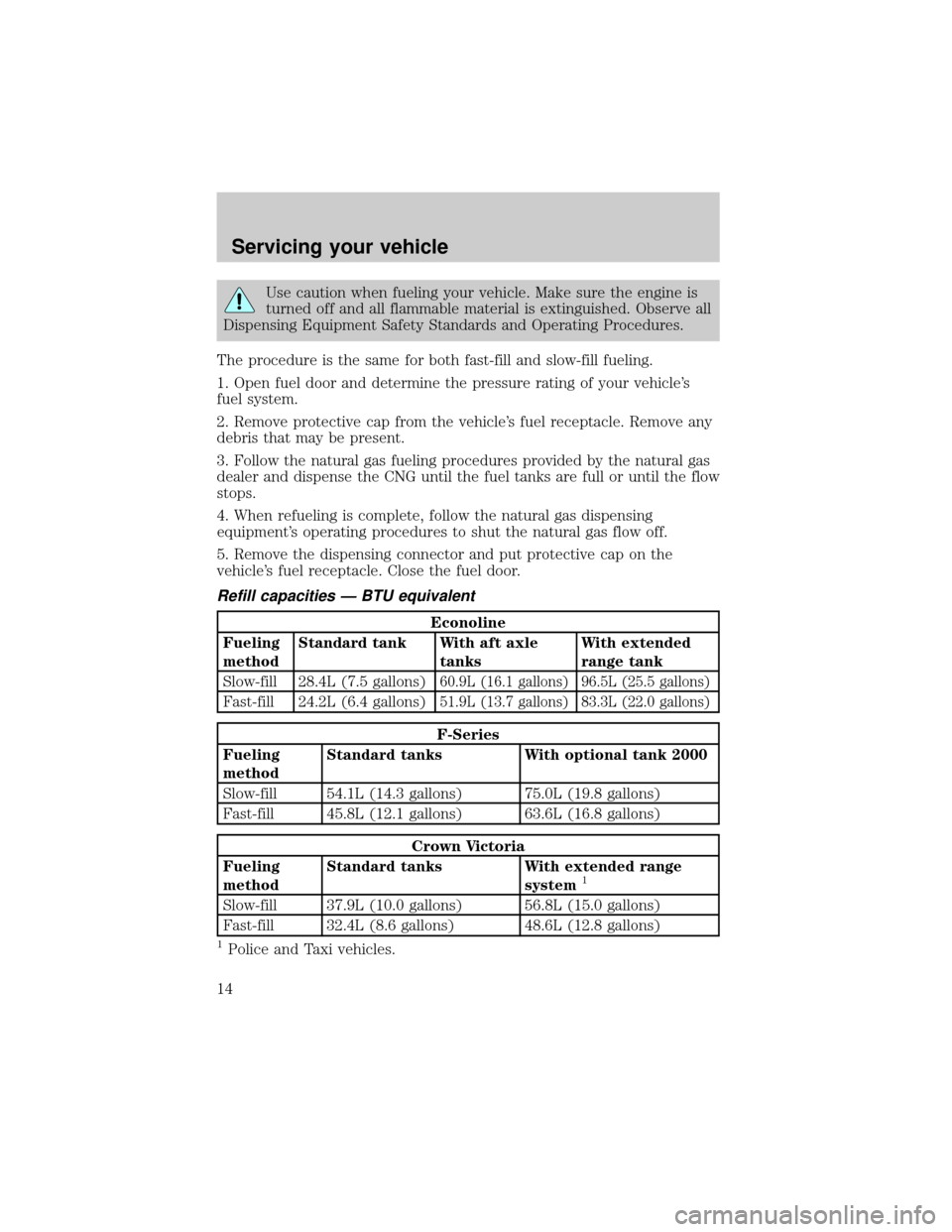
Use caution when fueling your vehicle. Make sure the engine is
turned off and all flammable material is extinguished. Observe all
Dispensing Equipment Safety Standards and Operating Procedures.
The procedure is the same for both fast-fill and slow-fill fueling.
1. Open fuel door and determine the pressure rating of your vehicle's
fuel system.
2. Remove protective cap from the vehicle's fuel receptacle. Remove any
debris that may be present.
3. Follow the natural gas fueling procedures provided by the natural gas
dealer and dispense the CNG until the fuel tanks are full or until the flow
stops.
4. When refueling is complete, follow the natural gas dispensing
equipment's operating procedures to shut the natural gas flow off.
5. Remove the dispensing connector and put protective cap on the
vehicle's fuel receptacle. Close the fuel door.
Refill capacities Ð BTU equivalent
Econoline
Fueling
methodStandard tank With aft axle
tanksWith extended
range tank
Slow-fill 28.4L (7.5 gallons)
60.9L (16.1 gallons) 96.5L (25.5 gallons)
Fast-fill 24.2L (6.4 gallons)51.9L (13.7 gallons) 83.3L (22.0 gallons)
F-Series
Fueling
methodStandard tanks With optional tank 2000
Slow-fill 54.1L (14.3 gallons) 75.0L (19.8 gallons)
Fast-fill 45.8L (12.1 gallons) 63.6L (16.8 gallons)
Crown Victoria
Fueling
methodStandard tanks With extended range
system
1
Slow-fill 37.9L (10.0 gallons) 56.8L (15.0 gallons)
Fast-fill 32.4L (8.6 gallons) 48.6L (12.8 gallons)
1Police and Taxi vehicles.
Servicing your vehicle
14
Page 15 of 16
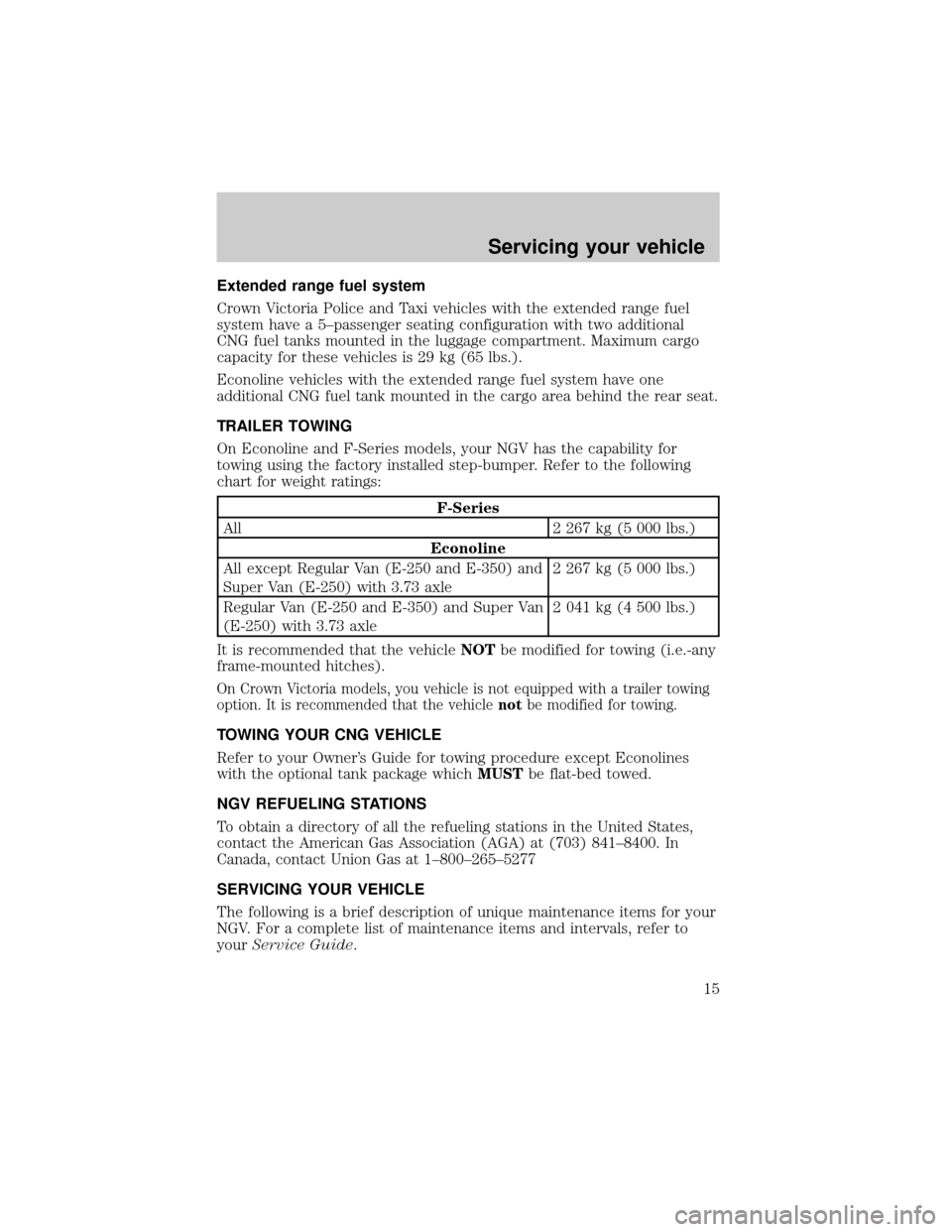
Extended range fuel system
Crown Victoria Police and Taxi vehicles with the extended range fuel
system have a 5±passenger seating configuration with two additional
CNG fuel tanks mounted in the luggage compartment. Maximum cargo
capacity for these vehicles is 29 kg (65 lbs.).
Econoline vehicles with the extended range fuel system have one
additional CNG fuel tank mounted in the cargo area behind the rear seat.
TRAILER TOWING
On Econoline and F-Series models, your NGV has the capability for
towing using the factory installed step-bumper. Refer to the following
chart for weight ratings:
F-Series
All 2 267 kg (5 000 lbs.)
Econoline
All except Regular Van (E-250 and E-350) and
Super Van (E-250) with 3.73 axle2 267 kg (5 000 lbs.)
Regular Van (E-250 and E-350) and Super Van
(E-250) with 3.73 axle2 041 kg (4 500 lbs.)
It is recommended that the vehicleNOTbe modified for towing (i.e.-any
frame-mounted hitches).
On Crown Victoria models, you vehicle is not equipped with a trailer towing
option. It is recommended that the vehiclenotbe modified for towing.
TOWING YOUR CNG VEHICLE
Refer to your Owner's Guide for towing procedure except Econolines
with the optional tank package whichMUSTbe flat-bed towed.
NGV REFUELING STATIONS
To obtain a directory of all the refueling stations in the United States,
contact the American Gas Association (AGA) at (703) 841±8400. In
Canada, contact Union Gas at 1±800±265±5277
SERVICING YOUR VEHICLE
The following is a brief description of unique maintenance items for your
NGV. For a complete list of maintenance items and intervals, refer to
yourService Guide.
Servicing your vehicle
15
Page 16 of 16
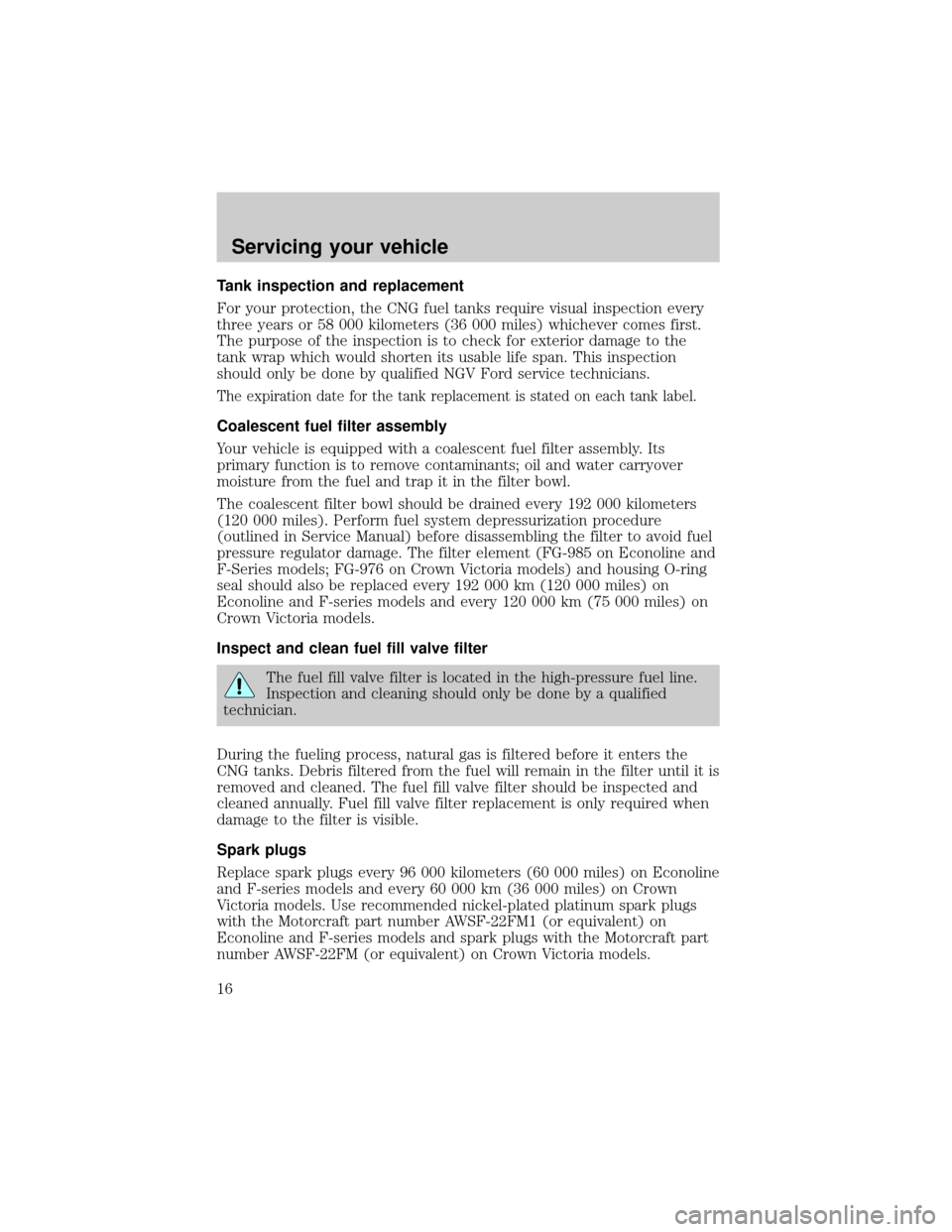
Tank inspection and replacement
For your protection, the CNG fuel tanks require visual inspection every
three years or 58 000 kilometers (36 000 miles) whichever comes first.
The purpose of the inspection is to check for exterior damage to the
tank wrap which would shorten its usable life span. This inspection
should only be done by qualified NGV Ford service technicians.
The expiration date for the tank replacement is stated on each tank label.
Coalescent fuel filter assembly
Your vehicle is equipped with a coalescent fuel filter assembly. Its
primary function is to remove contaminants; oil and water carryover
moisture from the fuel and trap it in the filter bowl.
The coalescent filter bowl should be drained every 192 000 kilometers
(120 000 miles). Perform fuel system depressurization procedure
(outlined in Service Manual) before disassembling the filter to avoid fuel
pressure regulator damage. The filter element (FG-985 on Econoline and
F-Series models; FG-976 on Crown Victoria models) and housing O-ring
seal should also be replaced every 192 000 km (120 000 miles) on
Econoline and F-series models and every 120 000 km (75 000 miles) on
Crown Victoria models.
Inspect and clean fuel fill valve filter
The fuel fill valve filter is located in the high-pressure fuel line.
Inspection and cleaning should only be done by a qualified
technician.
During the fueling process, natural gas is filtered before it enters the
CNG tanks. Debris filtered from the fuel will remain in the filter until it is
removed and cleaned. The fuel fill valve filter should be inspected and
cleaned annually. Fuel fill valve filter replacement is only required when
damage to the filter is visible.
Spark plugs
Replace spark plugs every 96 000 kilometers (60 000 miles) on Econoline
and F-series models and every 60 000 km (36 000 miles) on Crown
Victoria models. Use recommended nickel-plated platinum spark plugs
with the Motorcraft part number AWSF-22FM1 (or equivalent) on
Econoline and F-series models and spark plugs with the Motorcraft part
number AWSF-22FM (or equivalent) on Crown Victoria models.
Servicing your vehicle
16